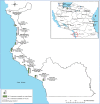Prevalence, infection intensity and geographical distribution of schistosomiasis among pre-school and school aged children in villages surrounding Lake Nyasa, Tanzania
- PMID: 33432079
- PMCID: PMC7801377
- DOI: 10.1038/s41598-020-80317-x
Prevalence, infection intensity and geographical distribution of schistosomiasis among pre-school and school aged children in villages surrounding Lake Nyasa, Tanzania
Abstract
Planning and implementation of schistosomiasis control activities requires an understanding of the prevalence, intensity of infection and geographical distribution of the disease in different epidemiological settings. Although, Tanzania is known to be highly endemic to schistosomiasis, there is paucity of data on the geographical distribution of schistosomiasis in potential large water bodies in the country. Thus, the present study was conducted to determine the prevalence, infection intensities and geographical distribution of schistosomiasis along villages located on the shoreline of Lake Nyasa, southern Tanzania. A cross-sectional study was conducted among 1560 children aged 1-13 years old living in villages located along the shoreline of Lake Nyasa. A single urine and stool sample was obtained from each participating child and screened for S. mansoni using Kato Katz (KK) technique to detect eggs and using point-of-care circulating Cathodic Antigen (POC-CCA) test to detect antigen in urine. Urine filtration technique was used to screen for S. haematobium eggs in urine samples. Villages/primary school were mapped using geographical information system and prevalence map was generated using ArcView GIS software. The overall prevalence of S. mansoni based on KK technique and POC-CCA test was 15.1% (95%CI: 13.4-16.9) and 21.8% (95%CI: 18.5-25.3) respectively. The prevalence S. haematobium was 0.83% (95%CI: 0.5-1.4) and that of haematuria was 0.9%. The arithmetic mean egg intensities for S. haematobium and S. mansoni were 18.5 mean eggs/10 ml (95%CI: 5.9-57.6) of urine and 34.7 mean epg (95%CI: 27.7-41.7) respectively. Villages located on the southern end of the lake had significantly high prevalence of S. mansoni than those located on the northern part (χ2 = 178.7838, P = 0.001). Cases of S. haematobium were detected only in three villages. Both S. mansoni and S. haematobium infections occur in villages located along the shoreline of Lake Nyasa at varying prevalence. These finding provide insights that can provide guidance in planning and implementation of MDA approach and other recommended measures such as improvement in sanitation, provision of clean water and behaviour changes through public health education.
Conflict of interest statement
The authors declare no competing interests.
Figures




References
-
- Steinmann, P., Keiser, J., Bos, R., Tanner, M. & Utzinger, J. Schistosomiasis and water resources development: Systematic review, meta-analysis, and estimates of people at risk. LancetInfect.Dis.6, 10.1016/S1473-3099(06)70521-7 (2006). - PubMed
Publication types
MeSH terms
LinkOut - more resources
Full Text Sources
Other Literature Sources

